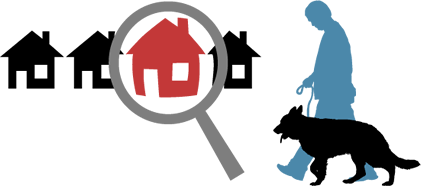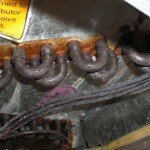Chinese Drywall Testing
One of the challenges in identifying Chinese drywall is that it entered the United States without being properly marked. Untrained trained experts can have difficulties interpreting the variety of improper markings on imported drywall. As a result it can be difficult to identify. With the exception that Chinese drywall off-gasses sulfur compounds it can often appear to be just like any other drywall. Hydrogen Sulfide and the acidic compounds are the corrosive components found to off- gas from Chinese drywall that cause metal components to deteriorate and purported to be associated with health problems in high concentrations.
How to test for Chinese drywall?
There are now three methods currently being used to determine the risk of having Defective /Chinese drywall present, K-9 DETECTION, ANALYTICAL (LAB) TESTING and the VISUAL DOCUMENTATION METHOD.
 The Certified K-9 detection method is the most current tool available. This method offers accuracy measured in parts per billion and is the most cost affective, non destructive method available today.
The Certified K-9 detection method is the most current tool available. This method offers accuracy measured in parts per billion and is the most cost affective, non destructive method available today.
Video of a K-9 in action:
Contact us to find out more about K-9 detection service.
 There a multitude of analytical testing methods available. The two most commonly used approaches are air sampling and material testing. Both are quite costly ($1200-$1800 per sample) they require a certified specialist to administer and a certified laboratory to analyze. Without going into great detail, air sampling is like taking a snapshot in time of the air inside the home and analyzing the components that comprise that air sample. Material testing requires a sample of the drywall be taken, documented with a chain of custody and analyzed in a laboratory. Both detection methods have inherent issues but produce some degree of results.
There a multitude of analytical testing methods available. The two most commonly used approaches are air sampling and material testing. Both are quite costly ($1200-$1800 per sample) they require a certified specialist to administer and a certified laboratory to analyze. Without going into great detail, air sampling is like taking a snapshot in time of the air inside the home and analyzing the components that comprise that air sample. Material testing requires a sample of the drywall be taken, documented with a chain of custody and analyzed in a laboratory. Both detection methods have inherent issues but produce some degree of results.
 The visual documentation method is widely used and the most commonly accepted method of determining the risk of having Chinese drywall present. This method consists of visibly inspecting (and photograph) the exposed metal components in a home to document the extent of their exposure to corrosive vapor. Discoloration and pitting corrosion are the markers identified. This is the most available method. It takes between 1-2 hours to complete and costs range from $200-$300. It can be performed by the homeowner with some handyman skills however; should be performed by an experienced building inspector, building contractor, architect, engineer, air-conditioning contractor, electrician or indoor air quality inspector due to its subjective nature. This method is subjective as different levels of exposure will cause different levels of discoloration and corrosion. The subjective margin of error increases in homes with low vapor levels or just a few boards of Chinese drywall in the home.
The visual documentation method is widely used and the most commonly accepted method of determining the risk of having Chinese drywall present. This method consists of visibly inspecting (and photograph) the exposed metal components in a home to document the extent of their exposure to corrosive vapor. Discoloration and pitting corrosion are the markers identified. This is the most available method. It takes between 1-2 hours to complete and costs range from $200-$300. It can be performed by the homeowner with some handyman skills however; should be performed by an experienced building inspector, building contractor, architect, engineer, air-conditioning contractor, electrician or indoor air quality inspector due to its subjective nature. This method is subjective as different levels of exposure will cause different levels of discoloration and corrosion. The subjective margin of error increases in homes with low vapor levels or just a few boards of Chinese drywall in the home.



